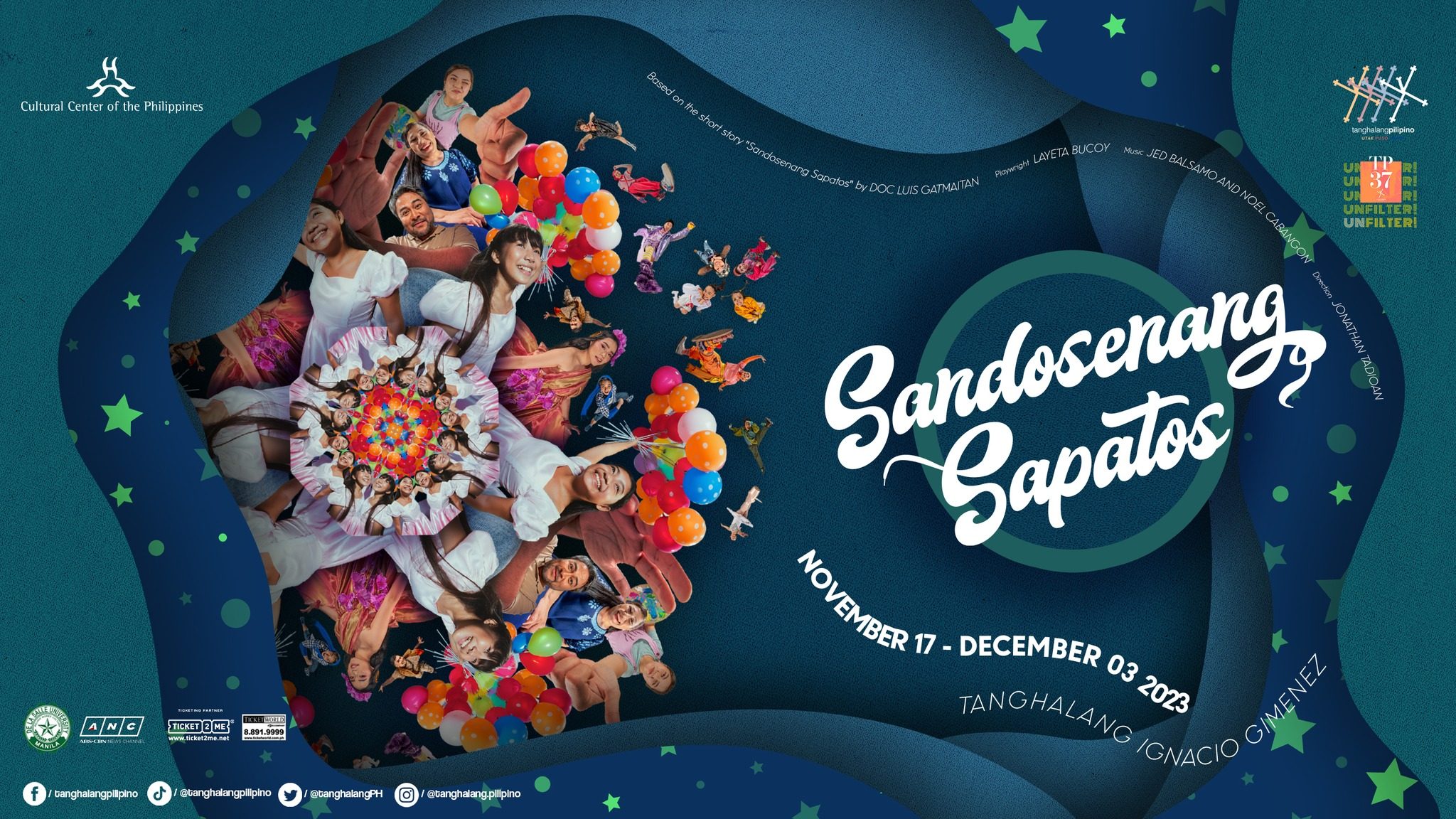SUMMARY
This is AI generated summarization, which may have errors. For context, always refer to the full article.

This year’s best productions feature stories that tap into our inner child.
Dulaang UP’s Kung Paano Nanalo sa Karera si Rosang Taba expands beyond its children’s book origins to incorporate themes of emancipation from slavery and land grabbing. Teatrong Bagong Mulat’s Prinsipe Bahaghari adapts Antoine de Saint-Exupéry’s classic into a visually dazzling puppet show. M. Manalastas’ Tuyom at Virgin Labfest peaks when a broken man is encouraged by his younger self to keep living. In Sandbox Collective’s Every Brilliant Thing and its Filipino counterpart Bawat Bonggang Bagay, the suicidal protagonist realizes how their mother’s struggles during their childhood shaped both their past and present intimacies.
Sandosenang Sapatos, Tanghalang Pilipino’s latest offering, follows suit. But while all five of the productions above feature adults returning to the world of children, Tanghalang Pilipino’s restaging centers itself on the life and interiority of a teen played by a teen.
Playwright Layeta Bucoy shifts Luis Gatmaitan’s original children’s book away from the caretakers and instead places us squarely in the subjectivity of Susie (Felicity Kyle Napuli, alternating with Wincess Jem Yana), a young girl born without feet who dreams of fulfilling her shoemaker father’s (Floyd Tena) dream of having a ballerina for a daughter. It’s a wish that her older sister (Mica Fajardo) has not even fulfilled and one that her mother (Tex Ordoñez-De Leon) attempts to shield her from. When the disappointment feels too great on her birthdays, Susie enters her dreams and the Shoe Fairy (Marynor Madamesila) temporarily grants her lower limbs, enabling her to walk, dance, and glide. But when her father shows signs of sickness, she goes on a crusade to have the Shoe Fairy give her feet in the real world, hoping to earn her father’s love before it’s too late.
On paper, the narrative is simple. Given the slate of Tanghalang Pilipino’s prior year, one would think that Sandosenang Sapatos is merely a break from the self-seriousness of the classics and the rigor of experimentation in devised theater. But having staged the production a decade ago, the decision to revisit Sandosenang Sapatos is inspired, given the progress in the politics of disability and art-making and how the pandemic became a mass disabling event we either witnessed or were a part of. To borrow film critic Emerson Goo’s point about Ryusuke Hamaguchi’s work: “Disability has always been socially invisible, but even more so in literature and film, where it’s often reduced to an isolated marker of tragedy, abnormality, or lack.” However, the value of centering such concerns in the Philippines, where conversations are few and far between and often restricted to the periphery of the peripheries, cannot be ignored.
Most of the writing around Sandosenang Sapatos praises it as a lesson of unconditional love towards Susie and how this can cure any self-perceived lack in a child. While such a reading aligns with the objectives of Tanghalang Pilipino, it limits the actual impact of the work. Instead, Sandosenang Sapatos can be interpreted as one of the few examples of children’s theater that attempts to reckon with the COVID-19 pandemic, whether intentionally or unintentionally. Most poignantly, it tackles Susie’s bodily reckoning but situates it within her coming-of-age as a young girl amidst isolation, clear allegories for the adolescent experience in the last three years.
Production designers Marco Viana and Paw Castillo create two distinct worlds that Susie inhabits, reflecting where she is and where she wants to be. Her room is windowless, defined by borders and geometric shapes, its appearance reminiscent of provincial ancestral homes built in the Spanish era. Its multitudes of browns are interrupted only by the color of her bed, a deep blue duvet littered with silver stars that embrace her in her sleep. Director Jonathan Tadioan uses this bed as a boat between the two realms. When Susie enters her dreamscape, she is transported by the ensemble to the other side of the stage — an area that is borderless and filled with stars that sparkle when lit through Gabo Tolentino’s lighting design.
Still, it cannot be denied that Sandosenang Sapatos hinges on the concept of how disabled people overcompensate for their perceived lack. But unlike a bulk of Western media and literature, the musical progressively reveals how these are rooted less in how Susie’s disability prevents her from being independent and more closely with her insecurities as a budding adolescent. Susie is not depicted as a tragic figure nor as a figure of pure naivete and empathy, mostly due to the strength that Napuli expertly imbues her with. On the contrary, her disability has made her acutely aware of her social class and the state of her father’s health, fueling her refusal to be treated as “special.”
If there were anything to nitpick about Sandosenang Sapatos, it is in how Bucoy and Tadioan render Susie’s family perpetually benevolent and happy. It makes sense from a narrative, directorial, and actors’ standpoint, as well as given its children’s book origins, to keep up a facade of optimism that shields Susie from the cruelties of the outside world. But it also renders their characters and relationships at times two-dimensional, bordering on inert. But more cruelly, they rarely match the complexity of Susie — who is at once bubbly, playful, and fierce but also heartbroken, disappointed, petulant, and profoundly rageful. Though we are exposed to her difficulties and interiority primarily through her dreams, why must her family only be on either end of the sliding scale between happiness and grief?
These lapses with Susie’s family become emblematic of how those closest to those who are disabled still struggle to care for them as regular human beings due to their prejudices. Susie’s mother and sister repeatedly coddle her, preventing her from developing the self-agency she needs as an adolescent. Susie’s father, aware of her insecurities, still decides to tuck away the shoes he made for her in her closet, inadvertently exacerbating her self-rejection. Disability cleaves the self from society and despite their immense love for Susie, her family at times reinforces her isolation through their overprotectiveness. But this is not only assuaged by their unconditional love but also by tools that she can use as a creative outlet and as a means to communicate with the outside world.
Still, Sandosenang Sapatos is emotionally raw without being nihilistic or cruel. When Susie’s father succumbs to his illness and her sister, in an act of kindness or obliviousness, prevents her from seeing him suffer, Susie laments to the audience as a way to distract herself from her momentary powerlessness. In an act of rebellion, she attempts to leave but her new laptop, what would eventually be the last remnant of her father, drops to the floor. Struggling to reach for it, she falls to the ground, clutches the metal to her chest, and maybe for the first time in the production, feels profoundly bound by her disability. What use are your father’s gifts when all you want is happiness you can’t seem to provide for him?
It is an image of profound despair that is necessary to punctuate the pain of growing up, of having unfulfilled wishes and bearing their consequences. Who hasn’t felt like a disappointment to their family? But Tadioan doesn’t dwell on this scene. He doesn’t give us time to form any pity towards Susie, to enact the same cruelties she inflicts upon herself. Instead, Tadioan surrounds her with her imaginary friends, all of whom without needing explanation provide her with equal amounts of emotional support and distance. When it is later revealed that these colorful creatures are physical embodiments of all of the shoes her father has made for her, of the love he has for her, one cannot help but shed a tear.
In a way, Tadioan and Bucoy create a Sandosenang Sapatos that asks its protagonist to unlearn these ideas that there is a completeness that must be chased after. Its conclusions might be quick and simple, at times questionably earned, but their saccharine quality never teeters towards the inauthentic. In historian Paul Longmore’s seminal work “Screening Stereotypes: Images of Disabled People in Television and Motion Pictures,” he laments that disabled adults in American film and television are often educated by nondisabled characters through tough love, their self-acceptance teased out through confrontation. But in Sandosenang Sapatos, there are no raised voices, only tenderness and healing. How lucky are we to witness it? – Rappler.com
Sandosenang Sapatos ran from November 17 to December 3 at the Tanghalang Ignacio Gimenez, CCP Black Box Theater.
Add a comment
How does this make you feel?

There are no comments yet. Add your comment to start the conversation.